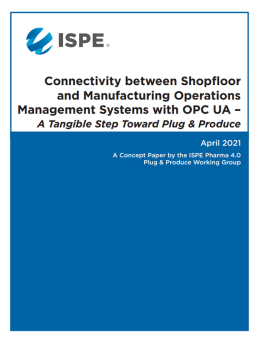Connectivity between Shopfloor & Manufacturing Operations Management Systems with OPC UA – A Tangible Step Toward Plug & Produce
1 Introduction
Within the pharmaceutical industry one sees a general drive toward utilizing data across all parts of the value chain. This implies that a plant or company has multiple systems that produce data and multiple targets where data must go. The primary problem of moving data is that many sources and targets do not possess a standardized means of exchanging that data. Projects to make data transfer possible nonetheless typically require large amounts of engineering time, cost significant amounts of money, possess large risks toward the meeting project timelines, bind resources in many companies, and produce inflexible custom solutions.
The past years have seen the emergence of new potent technologies such as OPC UA (Open Platform Communications Unified Architecture) and a change in mindset across the entire industry. Both are prerequisites for standardization efforts to create value. One goal of these standardization efforts is to achieve “Plug & Produce” capability of systems akin to the “Plug & Play” known from USB devices. We believe that for a system to be capable of Plug & Produce it must have several largely disjunct functionalities.
This Concept Paper presents a solution for standardizing one aspect of Plug & Produce, namely the transactional interaction between ISA95 Level 2 (L2) and Level 3 (L3) [1]. This solution introduces an OPC UA meta model that allows for the construction and implementation of a service-based transactional interaction. The authors believe that this approach has the potential to reduce project engineering time, costs, and risks, and enable solutions that are more easily maintained and changed. It is expected that this approach can be extended to target additional aspects of Plug & Produce.
Chapters 2 and 3 give insight into our thought processes and the solution derived from them. A specification-style description of the solution is found in the Annex (Chapter 5).
2 Motivation
The pharmaceutical industry is highly regulated and driven by strict GxP rules. As a result, the implementation of new facilities and equipment is costly and time consuming due to extensive test and documentation requirements. This is especially true with the connection between different systems (e.g., a machine and a Manufacturing Execution System (MES)), which requires a lot of qualification work, apart from the fact that until today, such interfaces were individually designed and customer specific.
This results in a limited capability for reusing data provided by systems, which in turn results in a limited actual use of data from production equipment and processes. MES are often implemented as “paper on glass” solutions where there is no direct connection to the process equipment. Data integrity remains one of the most urgent topics to be addressed, without having technical solutions to support or solve it by design.
